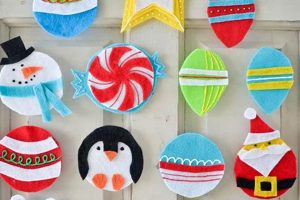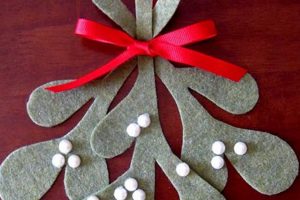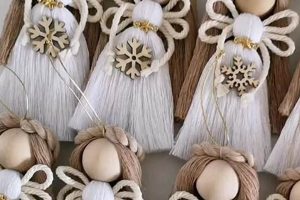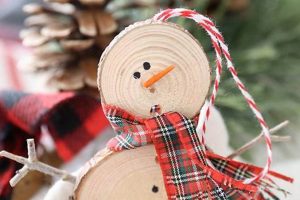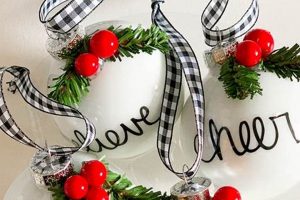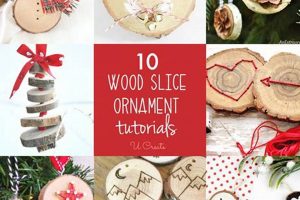The creation of decorative items for the holiday season using naturally sourced conifer cones represents a popular crafting activity. These handcrafted decorations frequently adorn trees and other festive displays, often involving embellishments such as paint, glitter, and ribbons.
This practice offers numerous advantages, including cost savings, personalization of holiday decor, and promotion of environmental sustainability through the utilization of natural materials. The tradition of using natural elements in seasonal decorations has historical roots in pagan winter solstice celebrations and evolved over time to become an integral part of modern Christmas traditions.
The subsequent discussion will address the sourcing of appropriate materials, various design techniques, and recommended safety precautions for constructing these unique holiday embellishments.
Crafting Decorative Conifer Cone Embellishments
The following guidelines aim to optimize the creation of visually appealing and durable holiday decorations using conifer cones, ensuring both aesthetic quality and longevity.
Tip 1: Material Selection: Opt for fully opened, undamaged cones. Proper drying is essential to prevent mold and ensure longevity. Cones should be baked at a low temperature to eliminate moisture and any potential pests.
Tip 2: Surface Preparation: Clean cones thoroughly to remove debris. A mild detergent solution may be used. Ensure complete drying before proceeding with decorative applications.
Tip 3: Adhesion Techniques: Employ industrial-strength adhesives for secure attachment of embellishments such as beads, sequins, and ribbons. Hot glue is generally effective but should be applied with caution to avoid burns.
Tip 4: Painting and Finishing: Use acrylic paints designed for craft projects. Multiple thin coats provide better coverage and prevent dripping. A clear sealant or varnish protects the painted surface and enhances durability.
Tip 5: Glitter Application: Apply glitter sparingly to avoid excessive shedding. Use a fine-mist aerosol adhesive specifically designed for glitter application to minimize mess.
Tip 6: Ornament Hangers: Attach sturdy ornament hangers securely. Consider using wire loops reinforced with adhesive to prevent detachment from the cone.
Tip 7: Storage Considerations: Store the finished pieces in a cool, dry location to prevent damage from moisture or extreme temperatures. Acid-free tissue paper can provide additional protection.
Adhering to these recommendations can significantly improve the overall quality, aesthetic appeal, and lifespan of handcrafted holiday decorations. Attention to detail in material selection, preparation, and finishing techniques is paramount.
The final segment will address common design choices and potential pitfalls in the creation of these handcrafted ornaments.
1. Sourcing
Sourcing represents the initial and critical stage in creating decorations using natural conifer cones. The quality and characteristics of the cones directly influence the final aesthetic and structural integrity of the handcrafted ornaments. Rigorous selection criteria are essential.
- Cone Species and Size
The choice of conifer species impacts the ornament’s visual texture and overall size. Different species exhibit variations in cone shape, scale patterns, and density. Larger cones may be suitable for statement pieces, while smaller, more uniform cones are appropriate for intricate designs.
- Cone Condition and Maturity
Mature, fully opened cones are generally preferred for crafting. Closed or partially opened cones may present challenges in embellishment and are susceptible to further opening, potentially compromising the ornament’s structure. Cones should be free from damage, such as cracks, breaks, or insect infestation.
- Collection Method and Location
Ethical and sustainable collection practices are paramount. Gather cones from the ground rather than directly from trees to minimize environmental impact. Select cones from locations free from pesticides or other contaminants. Private property access requires explicit permission.
- Drying and Preservation
Proper drying is crucial for preventing mold growth and ensuring the longevity of the ornaments. Cones should be thoroughly dried before embellishment. Baking at a low temperature (e.g., 200F) for a specified duration eliminates moisture and any potential pests. Air drying is an alternative, albeit slower, method.
Optimal sourcing of conifer cones ensures the creation of visually appealing and durable decorations. Adherence to ethical collection practices and meticulous preparation contribute to both the aesthetic quality and the environmental responsibility of the crafting process.
2. Preparation
In the context of crafting decorative items from natural conifer cones, the preparation phase is paramount to ensuring the structural integrity, aesthetic appeal, and longevity of the finished ornaments. Neglecting proper cone preparation can result in premature decay, pest infestation, or compromised adhesion of decorative elements. This stage is not merely a preliminary step but a foundational component that directly influences the success of the entire crafting endeavor.
Specific actions within preparation include rigorous cleaning to remove debris, thorough drying to eliminate moisture and prevent mold, and potentially, the application of a sealant to prevent sap leakage. For instance, if cones are collected from damp environments, simply applying embellishments without adequate drying will inevitably lead to mold growth, rendering the ornament unusable. Similarly, remnants of sap can interfere with paint adhesion, resulting in a substandard finish. The baking process, a common preparatory technique, serves a dual purpose: it eliminates residual moisture and neutralizes potential pests that may reside within the cone’s structure.
Ultimately, meticulous attention to preparation is an investment in the durability and visual appeal of the handcrafted holiday decorations. It mitigates the risk of future problems and ensures that the crafted pieces maintain their aesthetic value for an extended period, becoming treasured components of seasonal decor. The subsequent steps in the crafting process are contingent upon a sound preparation phase, making it an indispensable element in creating high-quality, handcrafted holiday decorations.
3. Adornment
In the crafting of “diy pinecone christmas ornaments,” adornment constitutes the pivotal stage where raw natural elements are transformed into visually compelling decorative pieces. The selection and application of embellishments directly impact the ornament’s aesthetic appeal and thematic resonance. Without adornment, a conifer cone remains simply a natural object; with it, it becomes a personalized symbol of the holiday season. For example, a pinecone lightly dusted with artificial snow and a miniature red bow evokes a traditional Christmas aesthetic, while a cone coated in metallic paint and adorned with geometric beads suggests a more contemporary style.
The practical significance of understanding adornment lies in its ability to tailor ornaments to specific design preferences or thematic motifs. The application of glitter, paint, ribbons, beads, and other decorative elements allows for customization that reflects individual artistic expression and complements existing decor. Moreover, the careful selection of adornments can enhance the perceived value of the ornament, transforming a simple craft project into a cherished heirloom. Consider the difference between a cone haphazardly covered in mismatched materials and one meticulously embellished with coordinated colors and textures; the latter exemplifies the power of thoughtful adornment.
The challenge in adornment lies in achieving a balance between visual appeal and structural integrity. Overly elaborate embellishments can weigh down the cone, compromising its ability to hang properly. Furthermore, the adhesion of adornments must be durable enough to withstand handling and storage. In summary, adornment is not merely about adding decorations; it is a considered process that transforms a natural object into a unique expression of festive creativity, requiring careful attention to detail and a nuanced understanding of aesthetic principles.
4. Attachment
In the construction of “diy pinecone christmas ornaments,” the method by which hanging apparatuses are affixed constitutes a critical aspect of the crafting process. Inadequate attachment can lead to ornament detachment, resulting in damage or loss. The structural integrity of the final product is directly contingent upon the secure and durable attachment of the hanging mechanism. For instance, a poorly glued ribbon loop may detach under the weight of the ornament, particularly if the ornament is heavily adorned.
The selection of appropriate attachment materials and techniques is paramount. Options include, but are not limited to, wire loops, adhesive-backed hooks, and embedded eyelets. The chosen method must be compatible with both the conifer cone’s surface and the weight of the intended adornments. A wire loop, for example, may be inserted into a pre-drilled hole and secured with epoxy resin for a robust attachment. Alternatively, a heavy-duty adhesive can be used to affix a metal hook, provided the surface is properly prepared and the adhesive is allowed to cure completely. The practical application of this understanding ensures that the ornaments remain securely suspended when displayed, enhancing their aesthetic value and preventing potential accidents.
Ultimately, the success of “diy pinecone christmas ornaments” is not solely determined by the aesthetic appeal of the adornments, but also by the functional reliability of the attachment. Addressing the attachment method with careful consideration mitigates the risk of ornament failure, contributing to the longevity and overall satisfaction derived from the handcrafted decorations. Prioritizing robust attachment techniques is essential for transforming a visually appealing craft project into a durable and enduring holiday tradition.
5. Finishing
In the context of crafting decorative conifer cone embellishments, the finishing stage represents a crucial process that enhances the durability, aesthetic appeal, and overall longevity of the handmade items. It encompasses a series of actions undertaken to protect and refine the ornaments after initial decoration.
- Protective Coating Application
The application of a clear sealant, varnish, or lacquer creates a protective barrier against environmental factors such as moisture, dust, and UV radiation. This coating safeguards the underlying paint, glitter, and other embellishments from degradation, extending the ornament’s lifespan. For instance, an ornament exposed to direct sunlight without a UV-resistant coating may experience fading or discoloration over time. Application techniques, such as spraying or brushing, should be selected based on the coating material and desired finish.
- Edge Sealing and Reinforcement
Sealing exposed edges and reinforcing delicate components prevents fraying, chipping, or detachment. This is particularly important for ornaments incorporating fabric ribbons, lace, or other fibrous materials. Edge sealing can be achieved with specialized adhesives or heat-sealing techniques, depending on the material. Reinforcement may involve adding extra adhesive or structural support to vulnerable areas.
- Surface Polishing and Refinement
Polishing techniques enhance the luster and smoothness of the ornament’s surface. This may involve the use of fine-grit sandpaper, polishing cloths, or specialized buffing compounds. Surface refinement can eliminate imperfections, such as brush strokes or uneven glitter distribution, resulting in a more professional-looking finish. The specific polishing method depends on the materials used in the adornment of the cone.
- Final Inspection and Quality Control
A thorough inspection ensures that all elements are securely attached, the finish is uniform and free from defects, and the ornament meets the desired quality standards. This step involves examining the ornament from multiple angles under adequate lighting. Any deficiencies should be addressed before the ornament is deemed complete. Quality control ensures consistent quality and enhances customer satisfaction.
These finishing techniques collectively contribute to the creation of durable and visually appealing conifer cone embellishments, transforming simple craft projects into enduring holiday decorations. Proper execution of the finishing stage elevates the perceived value and prolongs the usable lifespan of these handmade ornaments.
6. Preservation
The long-term maintenance of handcrafted decorative conifer cone ornaments constitutes a critical aspect of their overall value. Proper preservation techniques ensure that these items retain their aesthetic qualities and structural integrity across multiple holiday seasons.
- Environmental Control
Exposure to fluctuating temperature and humidity levels accelerates the degradation of organic materials and adhesives used in ornament construction. Storing these ornaments in a climate-controlled environment, such as a dry, cool closet, minimizes the risk of mold growth, warping, and adhesive failure. For example, storing ornaments in an unheated attic or damp basement exposes them to conditions conducive to deterioration, reducing their lifespan. This control directly influences their integrity.
- Pest Management
Natural conifer cones may harbor insects or larvae that can damage both the ornament itself and other stored items. Prior to storage, inspect ornaments for signs of infestation. Consider treating them with a non-toxic insecticide specifically designed for use on natural materials. Enclosing the ornaments in airtight containers or bags further prevents pest access. If an infestation is observed, isolation and appropriate treatment are essential to prevent further damage.
- Physical Protection
Ornaments are susceptible to physical damage during handling and storage. Wrapping each ornament individually in acid-free tissue paper or bubble wrap provides a protective barrier against scratches, impacts, and abrasion. Storing ornaments in compartmentalized storage boxes prevents them from rubbing against each other, minimizing the risk of damage. The type of storage directly protects their structure.
- Light Exposure Mitigation
Prolonged exposure to direct sunlight can cause fading and discoloration of paints, dyes, and other decorative elements. Store ornaments in dark or dimly lit areas to minimize light exposure. If ornaments are displayed in lit areas, consider using UV-filtering display cases or applying a UV-resistant coating to the ornament’s surface. This action protects them from color degradation.
These preservation strategies, when implemented collectively, significantly extend the lifespan of handcrafted decorations. They represent a necessary investment in maintaining the aesthetic and sentimental value of these cherished seasonal items. Without diligent adherence to these techniques, the long-term viability of these creations is compromised.
Frequently Asked Questions
The following section addresses common inquiries regarding the creation and maintenance of handcrafted decorations made from naturally sourced conifer cones. These answers provide insight into optimizing the crafting process and ensuring the longevity of the finished products.
Question 1: What is the optimal method for cleaning conifer cones prior to crafting?
The recommended approach involves washing the cones in a mild detergent solution followed by thorough rinsing. The cleaned cones should then be fully dried to prevent the growth of mold or mildew, typically through baking at a low temperature.
Question 2: How can conifer cones be effectively dried to prevent deterioration?
The most effective drying method involves baking the cones in an oven at a low temperature (approximately 200 degrees Fahrenheit) for a duration of one to two hours. This process eliminates moisture and sterilizes the cones, thereby minimizing the risk of decay.
Question 3: What types of adhesives are most suitable for attaching embellishments to conifer cones?
Industrial-strength adhesives, such as epoxy resins or hot melt adhesives, are recommended for secure attachment. The chosen adhesive should be compatible with both the cone surface and the materials being affixed. Proper surface preparation is crucial for optimal adhesion.
Question 4: How can the shedding of glitter be minimized when applying it to conifer cones?
To minimize glitter shedding, apply a thin layer of adhesive specifically designed for glitter application. After the adhesive has dried, a clear sealant can be applied to encapsulate the glitter particles. This technique reduces the likelihood of glitter detaching from the cone surface.
Question 5: What are the best practices for storing decorative conifer cone ornaments?
The optimal storage conditions involve a cool, dry environment, away from direct sunlight and extreme temperature fluctuations. Wrapping each ornament in acid-free tissue paper and storing them in compartmentalized containers provides protection against physical damage and environmental degradation.
Question 6: How can potential pest infestations be prevented in conifer cone ornaments?
Prior to storage, inspect the ornaments for signs of infestation. Baking the cones before crafting helps eliminate existing pests. Storing the ornaments in airtight containers or bags prevents new infestations. Consider using a non-toxic insecticide if necessary.
These answers underscore the importance of meticulous preparation, appropriate material selection, and diligent preservation techniques in creating and maintaining high-quality decorative conifer cone embellishments.
The subsequent segment will offer design inspiration and project ideas for those interested in creating personalized handcrafted decorations.
diy pinecone christmas ornaments
This exploration has delineated the multifaceted process of crafting decorations from natural conifer cones. Sourcing, preparation, adornment, attachment, finishing, and preservation constitute essential stages. Rigorous adherence to established techniques within each stage ensures the creation of durable and aesthetically pleasing seasonal decorations.
The information presented offers a comprehensive guide for individuals seeking to engage in this craft. Mastery of these techniques transforms a simple natural element into a personalized expression of holiday tradition, yielding enduring and meaningful adornments.


